Of all the home computer stories, Amiga is probably the most interesting, diverse and long. One reason for that is the number of machines Commodore produced for the Amiga line in an attempt to diversify and capture the market throughout the 80s and 90s. For that reason and to ensure you have adequate toilet breaks, this documentary will be broken into two parts, and following in the lines of chronological ordering, we begin, like all things, at the beginning.
To do that, we have to travel almost 40 years back in time, way back in the mid 1970s…..
Atari were expanding. Having developed arcade machines for several years, they were looking to expand their technology into living rooms throughout the world. To assist with this, a gentleman by the name of Jay Glenn Miner was recruited to develop custom integrated circuits by Harold Lee. Jay had been in the electronics industry for a number of years by this point, studying at electronics school in Groton, Connecticut and progressing to electrical engineering at California-Berkeley University in 1958. During his early work career he worked at various startups including General Microelectronics where he gained an impressive knowledge of MOS technology. Armed with his knowledge he successfully reduced the Atari 2600 display hardware down from a plethora of discreet components into a single Television Interface Adapter chip. The 2600, as we know, went on to be one of the most successful consoles of all time. Immediately after Jay would begin development of a new set of chips; the Colour Television Interface Adapter, Alphanumeric Television Interface Controller and Pot Keyboard Integrated Circuit, offering input and output control for the line of new Atari 8 bit home computers. At the time the designs Jay created were impressive, offering 40 on screen colours and custom accelerated circuity, allowing the 8 bit line to live well into the late 1980s. By this point, Atari had been sold to Warner Communications to provide suitable funding to market and deliver their home systems, but Ray Kassar CEO and the new corporate management was more interested in milking their current technology rather than advancing development. Jay and his team were keen to initiate a new project based around the spanking new Motorola 68000, but with Atari uninterested, left the company in 1980 and went back to medical development for a company called Xymos, helping to create a remote controlled pacemaker.

Another Atari employee who had left at around this time was the first 2600 programmer, Larry Kaplan. Larry was unhappy with the lack of recognition Atari attributed to their designers and had left in 1979 to found Activision. The first third party game developer who put game creators at the core of their work. In 1982 with the console market slowing somewhat, Larry felt the urge to pursue something more exciting. After seeing the Nintendo Famicom at the Consumer Electronics Show, He contacted his former colleague Jay, with the idea of creating a new company that would manufacture cartridges and peripherals for the Atari 2600. Investment was needed and along with a few wealthy dentists who were keen to cash in on the video game craze, Jay found additional interest, courtesy of his current employment. Bert Braddock, Jay’s boss at Xymos was keen to get both on board and on the company’s board. He quickly encouraging the Texas owner of Xymos to invest, and agreed to the team using the Xymos semiconductor labs.
And so in June 1982, work began from a small office at 7, 3350 Scott Boulevard, Santa Clara. With Larry as vice president and Jay in charge of the hardware, a chief executive & president was also brought on board; Dave Morse, head of marketing at Tonka Toys (and yes, that’s the same Dave Morse who would go on to head up Epyx. As we’re discovering with these documentaries, the same names crop up again and again). With a team in place and suitable investment, the name “Hi-Toro” was conjured for the venture, sounding both hi-tech and Texan. The founding idea was for Larry to design games for the Atari 2600 and other systems whilst Jay designed chips for the cartridges and other new accessories.
By October Bert Braddock was keen for Nolan Bushnell to come on board as board of director chairman. Larry called up his old Atari boss to suggest it, but in a twist, Nolan ended up convincing Larry to come and work for him. Only a few months after setting up Hi-Toro, Larry was gone, and Dave would ask Jay to take his place. The company was then split into two segments; One division, under Dave Morse would continue work on software and peripherals for existing game consoles, whilst under Jay’s guidance, the other would begin to focus on his old dream of creating a new computer system based around the Motorola 68000 processor. This required some convincing for their dentist investors. But still excited by the growing games market, they agreed to Jay’s plans to create a new powerful games console, whilst Jay slyly worked on the basis that it could be expandable to a full blown computer.
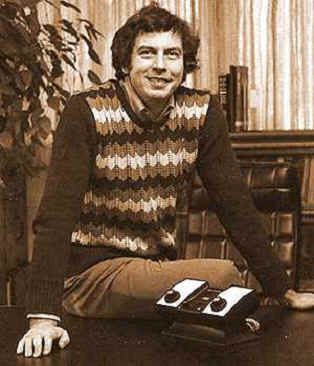
Codenamed “Lorraine” after the wife of Dave Morse – a naming tradition formed at Atari for labeling new chips after girlfriends so outsiders didn’t realise what they were discussing; the hardware plan was to create an advanced 16 bit gaming machine following in the open development practices of Commodore’s new 64 machine. Once the design was complete, the circuits would be hammered out at the Xymos Labs.
1983 would see the company named changed to something friendly and welcoming with their investors unhappy that the current name sounded too much like a Japanese lawnmower manufacturer, Toro. After several suggestions, including Amigo, the team finally settled on “Amiga”, a soft Spanish word meaning “female friend”… And I mean, the Amiga kinda did feel like a female friend, I guess. Also, like Acorn Computers, it came above Apple and Atari in the phone book – this really was cutting edge marketing for the 1980s. And so it was, the company was renamed to Amiga Incorporated, with one main objective and one side-line to supply funds and act as cover for their secret technology.
Whilst Jay worked on hardware, the other division worked on devices such as the “Powerstick” and “JoyBoard”, a kind of early Wii Balance Board, along with compatible titles such as Surf’s Up and Mogul Mania. These products weren’t really the success the team had hoped for, hindered further by the American video game crash of 83, which also brought with it a considerable degree of nervousness from their investors. Thankfully computer systems like the Apple II and Commodore 64 were still selling well and having unprecedented foresight Jay reassured investors by convincing them that the new hardware could be sold as a full and powerful computer system from the go. However additional investment was needed for which Jay would have to re-mortgage his house and borrow from other sources to keep afloat. Steve Jobs also visited the company a few times at this point but decided the hardware was too complicated to invest in.
Throughout 1983, Hardware development continued aided by additional colleagues from Atari and driven by Jay’s insatiable craving for design. The team Jay chose to recruit, all had one thing in common. They were looking to change the world, and Jay’s tolerant and flexible management style certainly helped this and crafted the feel of the Amiga. Members brought on board include programmers Dave Luck and R.J Mical, designers Joe Decuir and Dave Needle and even Jay’s beloved Coakapoo, Mitchie who came to work on a daily basis.
The custom architecture wasn’t new to Jay. The chips he’d designed at Atari are what made their 8 bit line so impressive for the time, offloading work from the 6502 CPU. Lorraine was also built around custom chip designs, freeing up cycled on the Motorola 68000 CPU, which although meaning it would be more expensive to manufacture, also allowed for arcade rivaling graphics. Something the entire team was very keen on nailing.
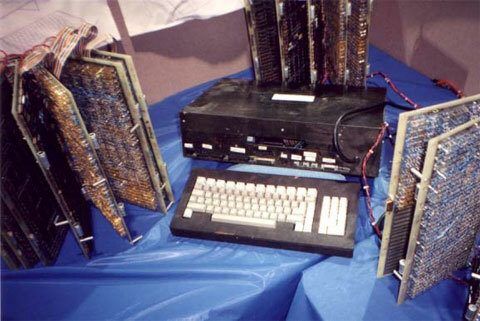
The chips in question were originally named Portia, Daphne and Agnus, and each had a specific task. Daphne would manage the display. Portia was in charge of sound and I/O tasks whilst Agnus synchronised them all to the CPU and memory whilst also housing the Copper and Blitter circuity which gave the Amiga such impressive animation abilities.
One of Jay’s inspirations for Daphne was a “Link Trainer” Flight Simulator machine, introduced to him by Al Pound at manufacturer Singer-Link. He wanted to use the Blitter (which can push large amounts of graphics around a screen quickly) to refresh frames fast enough to create a flight simulator in the home. This simulator was also the inspiration to incorporate a HAM Mode (Hold and Modify) that could place more colours on screen than memory allowed by changing the hue and saturation of existing pixels. This laid the path for the Amiga’s impressive 4,096 simultaneous on-screen colour mode, although in these early stages it could only muster 324 at the same time.
The complex designs were put together using wire and large boards in an anti-static area with an entrance sign saying “Ground Thyself”, as if you were entering a church of god, and in many ways, that’s almost true. In September 1983, Lorraine was completed in discreet form, which although unsuitable for retail, allowed some impressive demonstrations to be coded up on the advanced hardware. Along with Amiga’s sideline peripherals, one of these, the infamous bouncing ball, was on show at the Winter CES, but cutting it fine was an understatement.
At this point, the system had to be constantly maintained as components failed on the fly. Bob Pariseau had been brought on as chief of software design but hadn’t had time to implement a suitable operating system, so RJ Mical and Dale Luck worked non stop at the show to come up with something worthy of presentation. Lorraine didn’t even have a keyboard at this point and software had to be uploaded via. a SAGE IV remote terminal. The result was a red and white checkered ball that according to Dale only bounced, at this point, up and down, with no horizontal movement nor sound effects. But even so, it was enough to spike the interest of several investors who witnessed the system in a VIP only back room, and god knows that Amiga needed the money again at this point… Badly. Even the transportation of their equipment was done on the cheap by booking an extra airline seat and wedging it between them under the name of “Joe Pillow”, with smiley face drawn on for good effect.
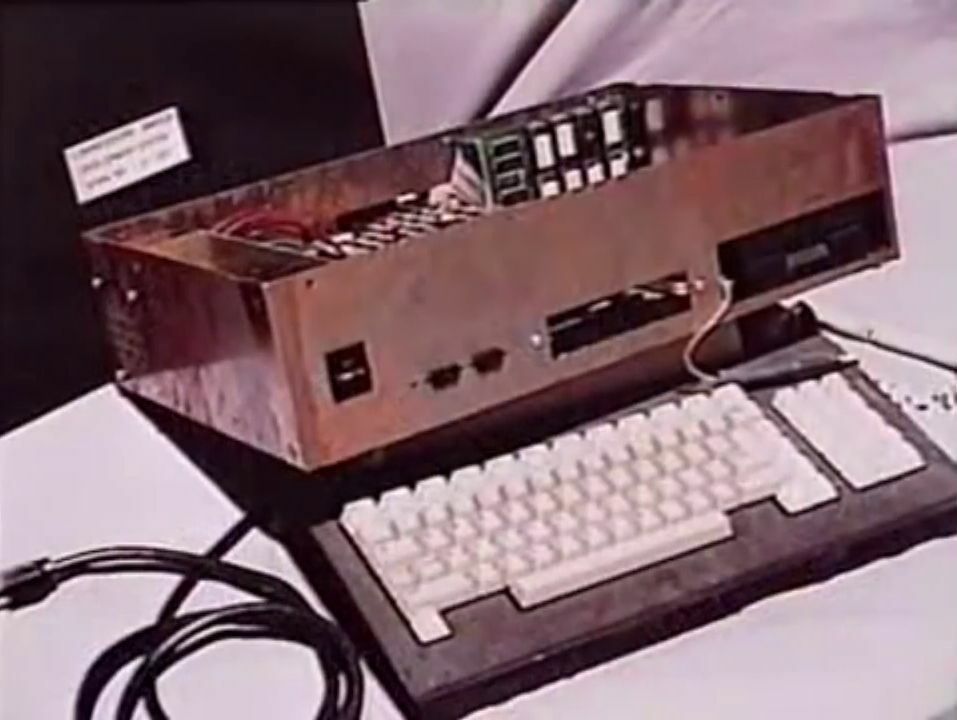
Amiga struggled on through the first half of 1984, fueled by passion, loans and foam baseball bats which the team would use to settle disputes in meetings. RJ Mical even wrote a meditation program for the “JoyBoard” where you had to sit as still as possible, without registering it’s sensors. This became a running joke and the inspiration for the fabled “Guru Meditation Error” we’re all very familiar with.
The kit was condensed a little, although still strewn across a variety of bread boats and hundreds of MSI logic chips, which accurately simulated the Amiga, albeit at a somewhat slower pace, and the bouncing ball demo was improved akin to the version we’re all familiar with today. Bob Pariseau, Dale Luck, RJ Mical and recruit Carl Sassenrath had also got stuck into the task of creating a suitable operating system for the machine, and the team would arrive ready for the June Summer CES with their latest hardware and bouncing ball demo, this time on wider display.
But what was it about this ball which garnered so much interest? Well.. the initial draw was the sheer size of the ball. Remember, this was an era when computer animation was always on the smaller side. There simply wasn’t enough power to chuck a tonne of pixels around in unison. The Boing ball was a whopping 140×100 pixels and seemed to jig around the screen completely seamless and mesmerising fluidity, much like a modern 3D rendering. However, there were some cunning tricks behind Lorraine’s big bouncing ball, thanks in part to the design of the hardware, rather than mapping out 14 frames of animation, the ball was completed using just one, through clever cycling of colour registers. The sound echoing from the ball is also from a single sample simply by changing the speed and volume. Bob Pariseau was recorded hitting an aluminium garage door with one of those foam bats and an Apple II digitised it from inside the garage. The demo is a testament to not only the team’s advanced hardware, but also to their sheer programming skill. Creating something brilliant, in limited time and with limited resources.

But this wasn’t their only trick. By now RJ Mical had created the basis of an application programming interface called Intuition. This was a window driven operating environment which took seven months of 100 hour weeks and like others was based around an early Xerox environment from the late 1970s. Combined with the Boing demo, the first glimmers of multi tasking, thanks to Carl Sassenrath’s revolutionary multitasking kernal called Exec – the core of the operating system – were tantilisingly evident, but really it was unncessary. By now several big names were interested in Amiga’s technology, keen to forge their place in the evergreen and rapidly evolving computer market. The main two were Commodore and Atari who were eager to jump onto the 16 bit bandwagon.
However with Commodore kicking it’s heels, it was Atari who stepped up first, offering to buy 1 million shares in Amiga at 3 dollars each whilst keeping the financially struggling company afloat, with a $500,000 loan whilst buy-out preparations were formalised. However, the contract for the loan was a strict one requiring Amiga to repay the entire loan within a month or Atari would be able to snap up their company for next to nothing. Clearly a filthy move designed to work in Atari’s favour, but Amiga were so desperate, they had no choice. Strangely, Atari weren’t even interested in finishing the computer Jay and his team had come so close to completing, instead they were looking to use the custom chips in their own machines.

Behind closed doors however, at Atari’s parent company, Time Warner, negotiations were taking place to find a buyer for Atari as it was currently loosing some $10k dollars per day. James Morgan, CEO of Atari was even unware of these negotiations himself, hence operations were business as usual. One of these negotiators, in early July was Jack Tramiel. Having recently left Commodore over disagreements he was looking for a new venture to sink into and Atari seemed ripe for the picking. A deal was quickly drawn up and Jack became the owner of Atari’s consumer division which was renamed to Atari Corporation. He would have also become the proud new investor/owner of Amiga incorporated at this point too, if it hadn’t been for his former company…. Commodore.
With Jack and his team of engineers departed from Commodore, the company was keen for a new machine and although late to the party, swept in before June was out and bought out Amiga from right underneath Atari’s noses. This included the repayment (with interest) of the $500,000 loan and a $4.24 per share investment in Amiga, taking ownership and bringing them in house as the new Commodore Amiga Incorporated. Upon finding this out, Jack was a little scythed and set about suing Jay and Commodore for breach of contract for $100 million dollars on August 13th, which would be finally settled out of court in Atari’s favour after a few years of shouting legalities at each other. Still, disruption was minimal for Jack as he began work on his own, new 16 bit machine, which would soon become known as the ST.
Back at Amiga, Commodore set about investing a further $20 million in the development of their new machine. Jay and his team may not have been running things exclusively anymore, but they were on safe and stable footing for the first time since 1983 at the company Jack Tramiel had first founded in 1955. Things were looking good.

The first task was to move the team out of their pokey little office into a spacious facility down the road in Los Gatos, California. More engineers were brought on board to expedite proceedings and their single Sage workstation was subsidised with another 10 so that everyone could work simultaneously. Work quickly progressed on two vital areas, the first was the chip design. Daphne was renamed to Denise, Portia to Paula and a lot of refinement began, including some technical improvements, an increase of memory from 128k to 256k and of course condensing the massive prototypes on actual silicon chips.

Although the team, particularly RJ Mical had completed some exemplary work on the Exec Kernal, Graphical interface Intuition and the new operating system, which as a whole was dubbed CAOS (Commodore Amiga Operating System) at this point, it was still taking time to develop into a usable system and needed operating system fundamentals such as file handing and resource routines. As part of the buy out, Commodore had imposed their own strict deadlines to get the system to market and so employed MetaComCo to port a version of TripOS and incorporate it into the Intuition code. TripOS was originally developed at Cambridge University on an IBM 3081, this was then ported to the Motorola 68k by Dr. Tim King. It’s fit with the Motorola chip meant that modifying it for the Lorraine chip set was reasonably straight forward, however the final results were still far below the original visions of Jay and his team, lacking many of the features they had intended, including resource tracking which would free up resources on the fly and a technically advanced file system. Still Workbench, working alongside the KickStart Boot ROM still made for a cutting edge operating experience compared to rival systems. This was still a time before Windows 1.0 had even been released.

Aside from the technical aspects, there was also the aesthetics of the new computer to deal with. Jay had a whole swave of design drawings which had already progressed, showcasing an elegant system in line with desktop systems like the IBM PC Junior, but some additional tweaks were put into place including a garage unit which allowed the keyboard to fit under the machine, suggested by Dave Morse, who was still present and managing the subsidiary, along with a pencil holder on the keyboard and a stereo start up tune. Not only did Amiga put a lot of time into the machine, but Commodore did as well, fully in the belief that they had hit the holy grail of the computing world.
Just 11 months after the purchase of Amiga Incorporated, the Commodore Amiga was unveiled at a lavish New York show at the Lincoln Centre on 23rd July 1985.
For this grand event, a full orchestra was hired, all Commodore and Amiga employees were shipped over and a lavish display was presented. Commodore’s Vice President Bob Truckenbrode hosted the show but it was Bob Pariseau who took charge of the machine’s real demonstrations.
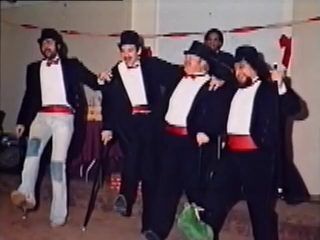
In many respects, the event was designed like a flamboyant version of the Apple Macintosh launch, and it showed the key stand out abilities of the new machine, but purpose and direction felt a little lacking. To end the display, the old faithfull Boing Ball demo was back, this time running on a full blown AmigaOS with Workbench file management and Intuition windows allowing tasks to be run simultaneously in the background whilst the ball bounced on regardless. The ball had become so synonymous with Amiga that it was originally uses for it’s official logo (something that holds true in more recent times), but Commodore decided to replace it with a rainbow checkmark, similar to the style of their earlier Commodore 64 detailing in a bid to identify the Amiga as a continuation of their earlier, and somewhat equally as impressive hardware.
The show was finalised by Andy Warhol and Deborah Harry (of Blondie fame) joining each other on stage to show case some of the machine’s graphical abilities, along with a helping hand of resident Amiga artist, Jack Hager. The paint program in question, called ProPaint was still in it’s alpha stages and had known bugs with the flood fill tool, however blissfully unaware Warhol went off on a flood fill pandemic, seemingly pushing the software to breaking point, but thankfully for Amiga, no freezes or glitches occurred.
Press coverage of the show seemed somewhat mixed. People were clearly impressed with the Amiga’s abilities, but the system was perhaps so far ahead of it’s time, that many didn’t know what these features could even be used for. It seems a little absurd now, but the industry was quite well entrenched in the IBM PC Compatible landscape of blandness. The Amiga was just pissing all over that and people didn’t know how to react.
The original machine was available as either a 256KB variant, or 512KB via a front expansion upgrade… something Jay had to plead with Commodore to incorporate, knowing that 256KB just wouldn’t be enough after the Operating System was loaded into memory. Other than being able to read to and from disk, there was very little in the way of ROM at this point also, with Kickstart loaded via. disk into a 256KB Write Control Store area of memory, which remained resident until power off. One reason for this was to iron out bugs in the code before incorporating a complete Kickstart ROM chip.
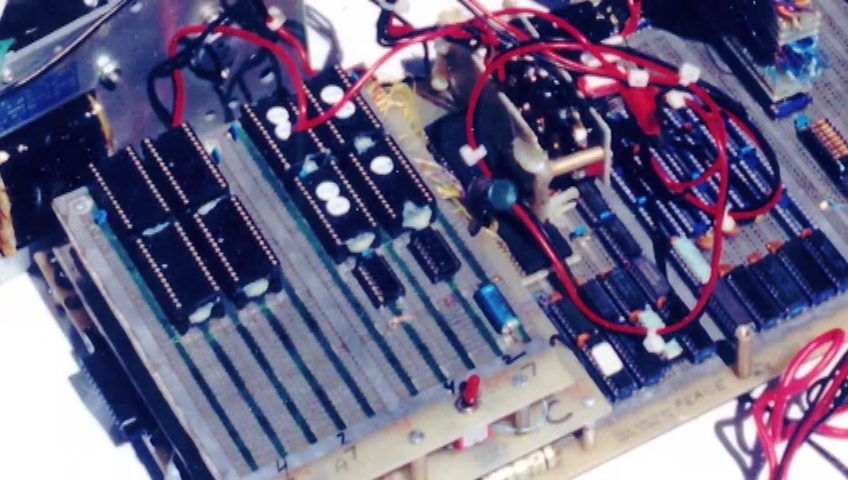
At it’s heart was of course the Motorola 68000 clocked at 7.16MHz (7.09MHz PAL)
The custom chip set, later known as the OCS or Original Chip Set comprised of our friends, Agnus incorporating the blitter block image transfer processor and the Copper, co-processor. Denise is on hand to fetch planar video data from the Amiga’s bitplanes and translate it into a color lookup as well as handling over videos modes. She can provide a borderless display with 640 x 256 pixels on PAL screens, which can be vertically doubled for interlaced display. Denise can also handle 8 16 pixel wide sprites on 3 separate layers in 4 colours, including transparent, or 15 colours when combined. Paula is still handling input, output, including the floppy drive, serial port and mouse ports, but also holds the Amiga’s audio capabilities. She comes with 4 DMA based 8 bit sample channels, split to allow stereo audio and also allows one channel to modulate another channel’s output allowing for basic FM synthesis effects.
Data is held by a 3.5″ Double Density floppy drive offering 880kB of capacity and a single Zorrro 1 card slot is provided on the right of the machine for expansion.
Port wise, the machine has a keyboard port, 2 mouse ports, an RS-232 serial interface, Centronics parallel access and an additional Floppy drive connector.
For video there’s an analog RGB out, a TV MOD output that can be used with an additional RF Modulator, and Composite outputs.
As a tribute to it’s creators, who put their heart and soul into this machine, the original models bear the molded markings of the entire team’s signatures, including a paw print from faithful Mitchie, who Jay apparently posed questions to and based many a decision around his K9 response.

In it’s sleek low profile package, the Commodore Amiga looked ahead of it’s time both technically and aesthetically, released for $1,495 for the 512kB model and $1,295 for the 256kB iteration in North America. An analog RGB monitor was available for an additional $300 bringing the cheapest package to $1,595. This was a price beyond most casual users but was still half the price of a 128kB Macintosh at $2,495 and cheaper than IBM PC-AT machines, whilst packing a hell of a lot more power.
However, there was one, slight thorn in this issue. Whist Commodore Amiga were frantically building away, Jack Tramiel and his team of ex-Commmodore staff over at Atari had been working even more frantically and had been successful in launching the Atari 520ST a whole month earlier, and not only that, but at a far cheaper price. $799.99 with a monochrome monitor and $999.99 for colour. If you consider that the Amiga didn’t even come with a monitor as standard, this was one hell of a deal. Of course it’s true that the Atari ST didn’t have the same custom abilities as the Amiga but even without those chips, Jack’s machine was still pretty advanced in itself. It also had the head start, further confounded by Commodore not getting Amigas out until November. And crucially, it had the price.
Rather than unveiling a golden ticket unrivaled by other machines, Jack had got back at his former company within just a few months and thrown Commodore Amiga into a furious competition from the go.
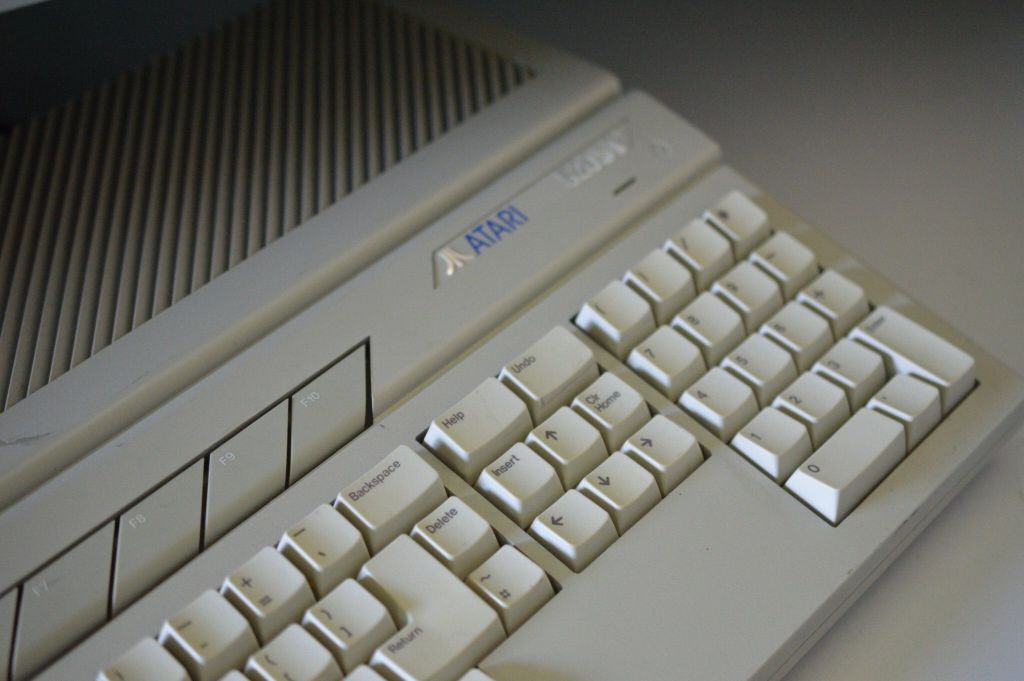
By riding on higher development costs and choosing a price point over $1,000 Commodore had immediately placed their Amiga into the high end computer workstation market, fighting the likes of Apple and IBM. This was a market where software mattered. Where spreadsheets and productivity were king, and as a new machine, the Amiga simply lacked a great deal of software. Atari’s pricing had placed their machine into big player in an entry level price zone, opening up the system for a swathe of new users wanting to get into something new and exciting. This early discrepancy meant the ST was initially outselling the Amiga and as a result gathering a reasonable degree of software houses looking to work on it, including game developers. However, Amiga did still have the wow factor, along with a few other cards beginning to fall nicely from their sleeves.
One of these cards came from the then innovative Electronic Arts headed by the familiar face of Trip Hawkins. Before, after and during the Amiga’s debut, the aspect which received the most interest was its remarkable graphics capabilities. Able to display 32 colours on screen from a palette of 4,096 in low res and 16 in high res, not to mention it’s 64 and even 4,096 colour HAM mode, these abilities dumped all over Apple’s monochrome Mac, IBM’s 4 colour CGA and even beat the Atari ST‘s maximum of 16 out of a palette of 512. Amiga’s various demos showcased these abilities, but if software was available which allowed users to really capitalise on this ability, then the purpose of the Amiga would start to become clear.

Deluxe paint, a rewrite of their Prism package for DOS really brought the tools to the table, and artists inspired by the appearance and continued work of Warhol on the machine began popping up. In a shrewd move, Commodore had given EA access to prototype machines several months ahead of the launch date, allowing Trip Hawkins and his team to really see the machine’s potential. Before this point, most programs had their own file formats, in a bid to lock users into their line of software, however EA were the first to really integrate a literal Interchangeable File Format (.IFF) into their package developed by Jerry Morrison. This .IFF format acted as a container, allowing images, sound, graphics and animations to all adopt this universal format. Combined with the new features offered in Deluxe Paint, which rather than presenting basic digital tools, seemed to re-create an artist studio in the computer, it opened up a door way for a generation of new artists and graphical tweakers who could begin to unlock the wonders of this new machine or just play around with a wealth of colour and bathe in its on screen glory. If the IBM had found it’s niche with business and spreadsheet programs, the Mac with desktop publishing and the ST with music production, the Amiga was just beginning to find its footing in the world of graphical superiority.
Released in November 1985, Deluxe paint was one of the first in a line of Electronic Arts releases which would help propel the Amiga forward and solidify its place in computer history.
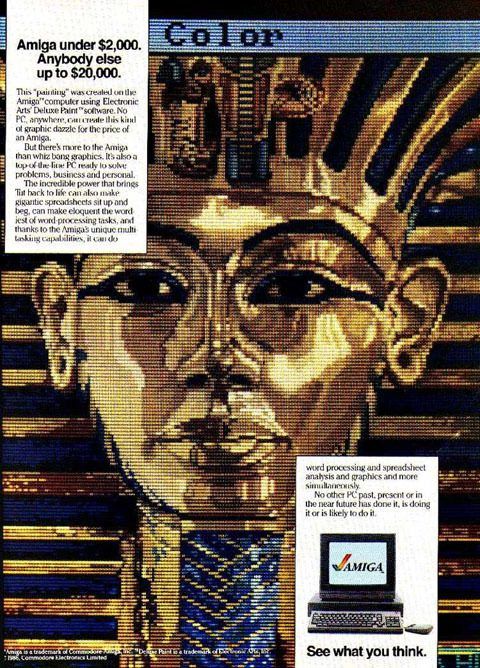
Strangely, games, the software genre the machine was apparently ideal (and originally developed) for had barely got a mention so far. The launch party was devoid of any nod and Commodore seemed to be glossing over the subject altogether. This was alas, an early sign of the mismanagement the Amiga would receive as Commodore tried to establish its identity and purpose. The trap they had fallen into was the trap of “the serious”. The notion that expensive technology can’t be seen as a frivolous entertainment machine at the cost of losing credibility. This was in part a notion IBM and Apple had come up with to make their machine’s lack of graphical and sound abilities come across as a selling point. Rather than breaking this mould and declaring how revolutionary and ideal for the task their machine was Commodore fell right into it, opting for the business computer pitch, and although games would also immediately begin to emerge on the system, they didn’t really showcase the hardware. Mostly being conversions from other, lesser machines or just ports from games which were already available on the Atari ST. In part Commodore still viewed their 64 as the low end gaming machine, which indeed it was, but the market was ready for a leading light, something to shine the way, even at a high price.
Commodore were also under some strain, having confusingly launched their original line upgrade, the Commodore 128 earlier in the year, alongside the poorly selling Plus/4 range, their resources and profits were becoming thinner. The Commodore 64 was still being sold, and selling well, at big retail chains, but the Amiga wasn’t even stocked in them, with Commodore even turning down an offer for Sears to stock the new hardware, an outlet where Atari STs were stocked and selling. Instead Commodore seemed to continue their emulation of Apple’s sales techniques with a zombie based advert, similar to Apple’s famous 1984 ad and a bizarre presentation based on 2001: A Space Odyssey. The advertising continued, apparently trying to sell alone off the Amiga’s abilities and even moved to soul-less comparison shots before the year was out.
Combined with the delayed production, lacklustre personality and muddled direction, the Amiga only sold 35,000 in 1985, and this wasn’t helping with Commodore’s cashflow, leading to the company bailing on the January 1986 Consumer Electronics Show. This didn’t go amiss from the press who noted that after establishing their brand at that very show, it was akin to Russia resigning from the Soviet Bloc.
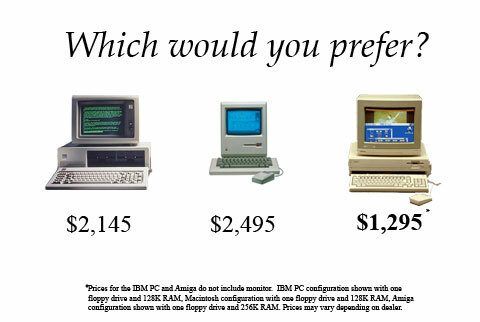
Thomas Rattigan, former CEO of PepsiCo International was installed as CEO in February 1986, replacing Marshall Smith, and immediately began a much needed plan to redirect the companies operations and make the most of their frankly, ground breaking technology. By now the Amiga was selling approximately 10,000 machines per month. A figure the Atari ST was beating, along with dealer signups and software support, leading to further software ports from the ST which just made the Amiga look like a high cost version OF the ST. Rattigan’s plan was to first cancel well overdue lines such as the PET, VIC-20 and Plus/4 and then create 2 versions of the Amiga hardware. The first would be a high end desktop aimed at the creative markets. The second would be a cost-reduced version designed to replace the Commodore 64 and 128 models. Finally a clear path was beginning to be laid.
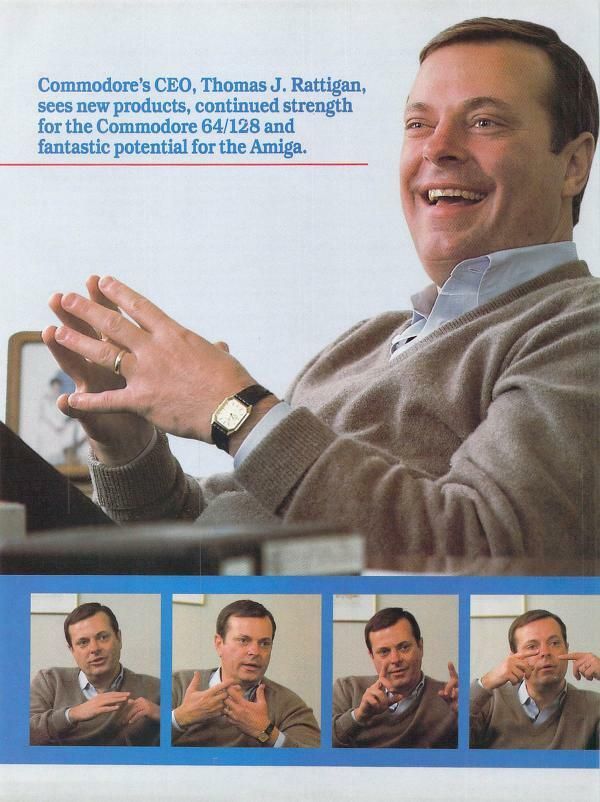
Whilst these plans were being laid, Jay’s original team based in Los Gatos were clearly still disgruntled by the handling of their precious technology. To this end, whilst working on Workbench 1.1, an un-named engineer tucked an Easter Egg into the operating system that would appear when a certain combination of keys were pressed (“We made the Amiga, they fucked it up”). RJ Mical discovered it and although finding it amusing, asked the engineer to change it. However, it was merely encrypted and the first batch of European PAL Amiga’s flashed the message on screen for 1/60th of a second if you held down 8 keys and inserted a disk at the same time. Apparently someone with keen eyes spotted this, and recorded the output to a VCR, which even with shoddy 1980s freeze frame ability, allowed it to be shown to Amiga executives, who quickly pulled thousands of machines from UK shelves. Given that it was unlikely to ever be found by users, pulling the machines and suffering a 3 month sales delay whilst new ROMs were fitted seems a costly and strange measure to take. But then it wouldn’t be the first we’ve encountered in the Amiga saga.
Shortly after, Commodore decided to move the Los Gatos team closer to head quarters in West Chester, Pennslyvania, whilst making several lay offs in the process, due to cost cutting. Some of the remaining team did as bade, however Jay Miner had had enough and decided to exit the endeavor and an official employee, and instead work as an external consultant for the company from his home town. To further reduce Commodore’s overheads, staff and other internal projects were discarded. This included projects like the Commodore 65, the Commodore 900 Unix workstation and even Commodore’s office branding and supplies which had helped establish the company in its infancy.
Rattigan then set about his plans. Proposals for the high end machine were first given to Commodore’s German subsidiary, who had recently been responsible for launching Commodore’s IBM PC Compatible range. Armed with this fresh PC knowledge their idea was to incorporate an open architecture into the new Amiga, expanding the bus and allowing ISA cards as well as Amiga Zorro cards to be added. A dedicated video slot was also introduced allowing a genlock card upgrade. This allowed computer images to be placed on top of video seamlessly, and fitted perfectly with the Amiga’s native video editing abilities. The Amiga was really defining the Multimedia platform as it went, and it would pave Amiga’s way into the standard machine of use in the video industry.
The final case and keyboard wasn’t as elegant as the original model, but that’s in part thanks to another cost cutting measure of using the cancelled Commodore 900 workstation case as the housing. The new machine launching in March 1987 would be called the Amiga 2000, instigating a name change of the original Commodore Amiga to the Amiga 1000. It retailed for a hefty $2395, armed with 512kB of RAM as standard and including a monitor from the off. Immediately its path was sown and advertising was launched hitting home the machine’s intended niche and selling points.
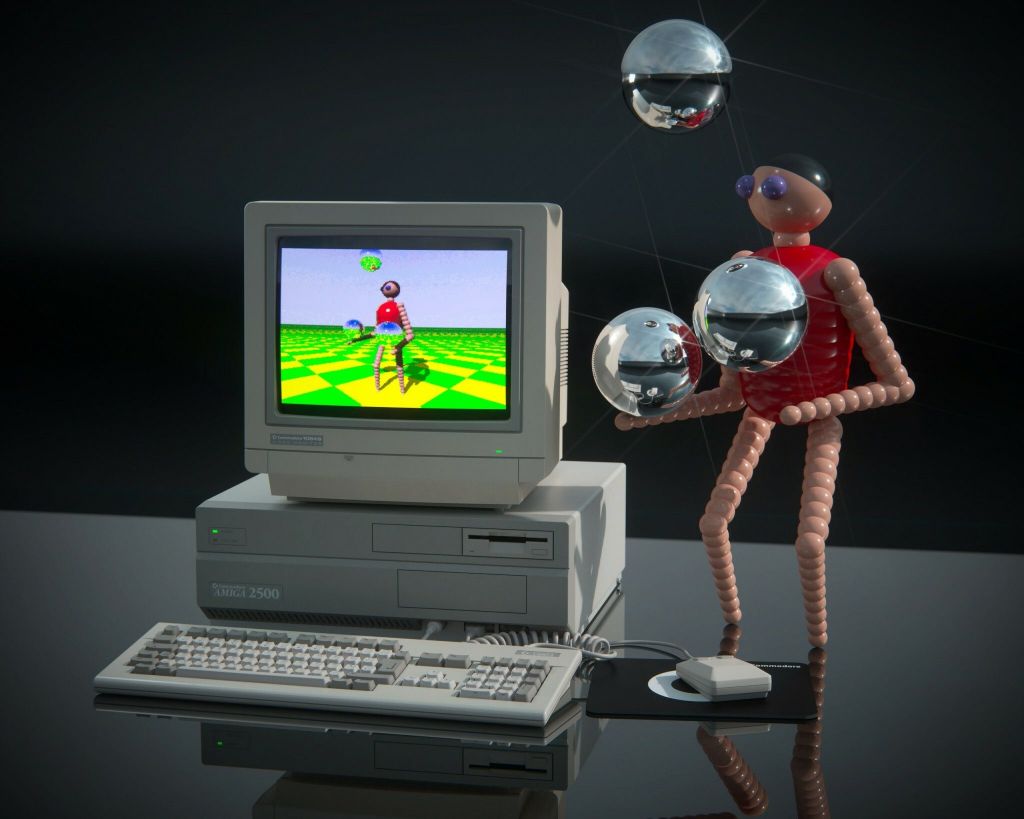
At the other end of the scale work had also begun on a low end Amiga, dubbed the 500. Engineer George Robbins was keen to jump on the project from the go, having pitched for such a machine from the start, fitting much more in line with Commodore’s earlier systems and indeed the expectations of developers and consumers alike. Commodore’s core group of engineers were put to task on the machine with Jeff Porter in charge – who had previously been working on a cancelled Commodore laptop. Along with Robbins, Bob Welland headed up the engineering of the system who set about shrinking the Amiga 1000 hardware, along with some subtle improvements. One of these was the upgrade of Agnus to Fat Agnus, allowing the system to be upgraded with 512kB of pseudo fast RAM. The motherboards were codenamed after a B52 song Rock Lobster, which you can find printed on the boards.. a trend which would continue with future Amiga variations. The new case design was very much conceived to flow on from earlier Commodore machines and the recently revamped Commodore 64C model, and so a sleek wedge case was molded offering floppy disk access on the side much like Atari’s also updated 520STFM model. It seems whatever the Amiga was doing, Atari were always so very slightly ahead. Still, the Amiga 500 was planned for launch in July 1987 but arrived a few months late in October for the budget price of $699 in North America and £499 in the UK, and was ready to go head to head with the Atari ST and wangle its way into homes and living rooms throughout the world.
Not long after this the 2000 model, having shipped 60,000 units was updated to include some of the 500s design improvements and a few updates with US based Dave Haynie and Terry Fisher taking the task to hand. A new Buster chip was integrated to manage the expansion bus, also allowing plug and play functionality, another ahead of it’s time feature. A Co-processor interface was added for CPU upgrades and of course Fat Agnus was integrated, giving the 2000 a much needed 1mB memory boost.

It appears that once again, Commodore were finding their footing. Thomas Rattigan had begun to turn things around, posting $28 million in profits for the previous financial year, but yet, this apparently displeased chairman Irving Gould who seemingly had a bone to pick with Rattigan, possibly an egotistical disturbance, its hard to be sure. But Gould accused Rattigan of conducting himself in a “high profile manner”, whatever that means… to me it sounds like he just didn’t like the guy, and a consulting firm was hired to quickly concluded that Rattigan should be fired. This was promptly executed by Gould in April 1987, and Rattigan found himself booted out of Commodore the very next day to the bewilderment of fellow staff members. He would subsequently sue Commodore for breach of contract and finally win in 1991 for $9 million dollars, but be unable to complete the work he had begun.

We’ll never know what difference he would have made to the greater picture of Amiga, but for now Commodore had 2 new machines, and a healthier set of accounts, and was about to launch the Sidecar, allowing the 1000 to serve as a full PC-XT clone. So, what about software for these machines? After all, we know its pretty essential……. Well, ready for the 500 in particular, one game had shone the way since the late 1986 World of Commodore show…. Defender of the Crown.
Defender of the Crown almost defined a new genre of game. It burst open the boundaries of experience you could reap from a gaming world previously filled with abstract concepts or frantic action. Here was a game, which as it’s appropriately named creators had envisaged, was essentially a play along film. For the Amiga, it was an experience which tied well with the multimedia principles the hardware was designed for. Underneath it’s really a risk like game, dotted with a plethora of mini-games, but it was the colourful, high quality graphics which really caught the eye of gamers currently squinting at their 8 bit screens. Older hardware really needed an overlay of imagination to bring it to life. In Defender of the Crown, there was no need.
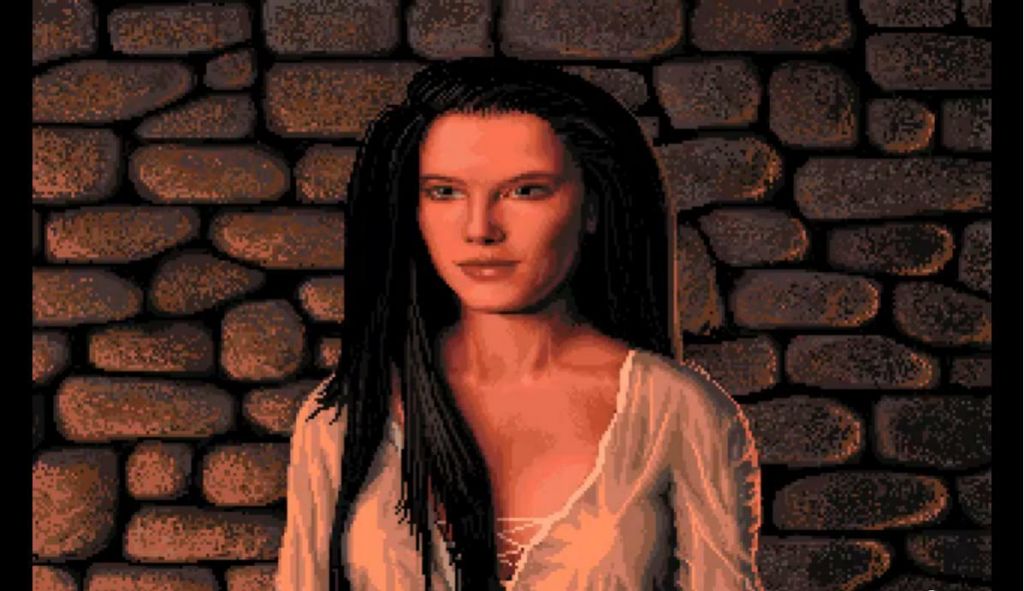
Bob Jacob, Cinemaware’s founder was no stranger to game development, having worked on a number of Commodore 64 titles, but having witnessed the Amiga in its early days, he really got a sense of what the machine could do and built a development company to specifically take advantage of that. Although even the best Amiga games were selling only 25,000 copies in 1986, Commodore 64 versions were selling over 100,000 more. Jacob’s idea was to wow the press and consumers with the Amiga game releases, and then follow them up with cut down versions on other hardware. It was a strategy which worked and really set the scene for the Amiga as the games machine it was.
RJ Mical was actually contracted to re-write the Amiga version and it turned out to be one of the best and most impressive incarnations. Almost 200,000 Amiga’s had been sold by the end of 1986, but the new 1987 machines heralded a different approach, and keen to gloss over their earlier mishaps, Commodore asked the press to refer to the new machines as “The Amiga, from Commodore”, with new logo designs on cases. This pushed the Amiga as almost a separate entity, and helped dispense confusion from Commodore’s continued Commodore 64 and 128 lines.
With the Amiga 500 launched, sales began to pick up in the all important home market, but the machines were still expensive and relied on their impressive capabilities to sell. Nintendo was currently dominating the home console market with the NES in North America and Sega was gaining traction with the Master System in other regions. These consoles were cheaper than home computers, in part because they relied on receiving most of their revenue from game licensing models. This meant that although hardware was cheap, games were more expensive, and it was also harder to publish on them. One of the distinct advantages with machines like the Amiga, was their open platform. Practically anyone could create their own software on disk and publish it. This quickly meant a wave of new software was created for the machines. Some conversions from the Atari ST, some brand new and some was just coded by people at home and released as Public domain software…. an area which would grow rapidly over the next few years.
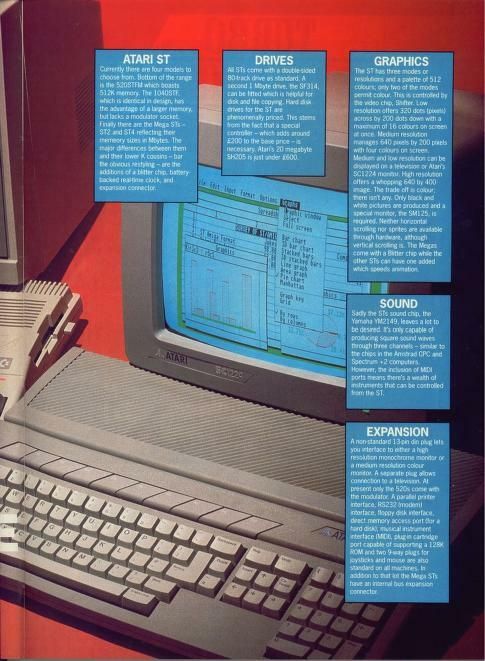
Although the new systems were selling in America, it was over in Europe where things were looking much more rosy.
Since it’s launch, the Atari STFM in particular had gained a foothold as the must have computer upgrade for current Sinclair Spectrum, Amstrad and Commodore 64 owners. This was a region much more used to plonking a full blown computer in front of the living room television for both gaming, and general tinkering. It’s this tinkering which grew the number of European development houses so quickly, and eager for new technology, many of these developers had moved onto the ST when it arrived. Armed with Motorola 68000 knowledge, the Amiga seemed a natural and exciting progression and although in the UK only some 50,000 500’s were sold in the first year, soon games were released which really took advantage of it’s custom hardware.
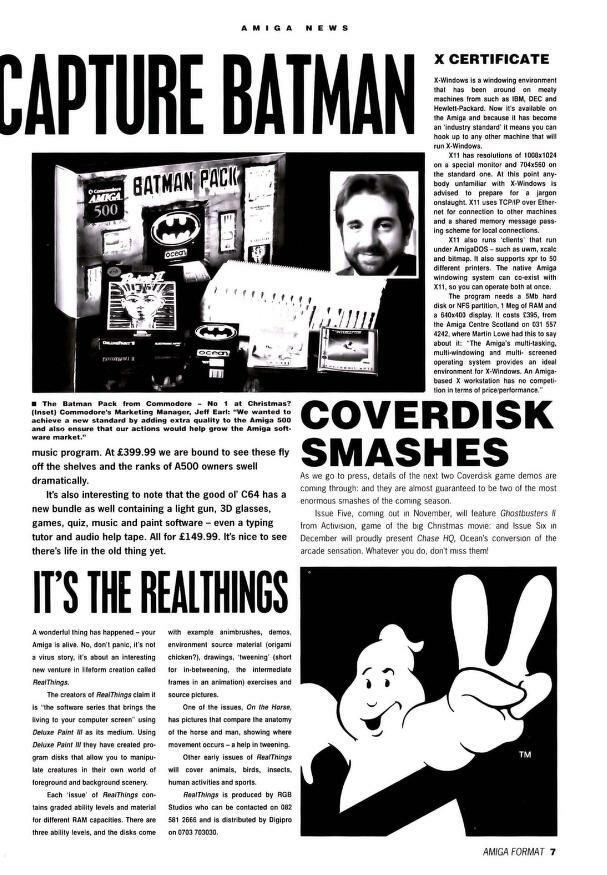
In 1988, the number of 500 systems sold increased in the same region increased to almost 150,000 and it looked like Commodore UK and European based gamers, at least, were onto a winner. Another key reason for this was the tactics which Commodore UK employed over their American counterparts. Instead of bundling the Amiga 500 with business and educational software, followed by further mundane adverts, David Pleasance, the UK sales and marketing director set about creating entertainment based packs, which echoed earlier bundles from Commodore and even Sinclair, under Amstrad’s rule. One of these packages in particular was the Batman pack, incorporating an A500, along with the new Batman game, based on Tim Burton’s 1989 classic, as well as The New Zealand Story, Interceptor and Deluxe Paint 2 for just £399. A similar pack was also released for the Commodore 64, but the Amiga was exciting, it was powerful, it was glorious.
These key moves increased annual machine sales to over 200,000 by 1989 and what’s more, the Amiga was just getting started.
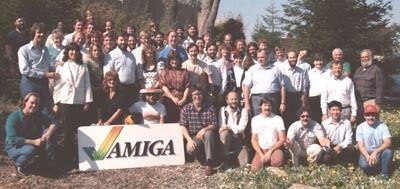

Nostalgia Nerd is also known by the name Peter Leigh. They routinely make YouTube videos and then publish the scripts to those videos here. You can follow Nostalgia Nerd using the social links below.
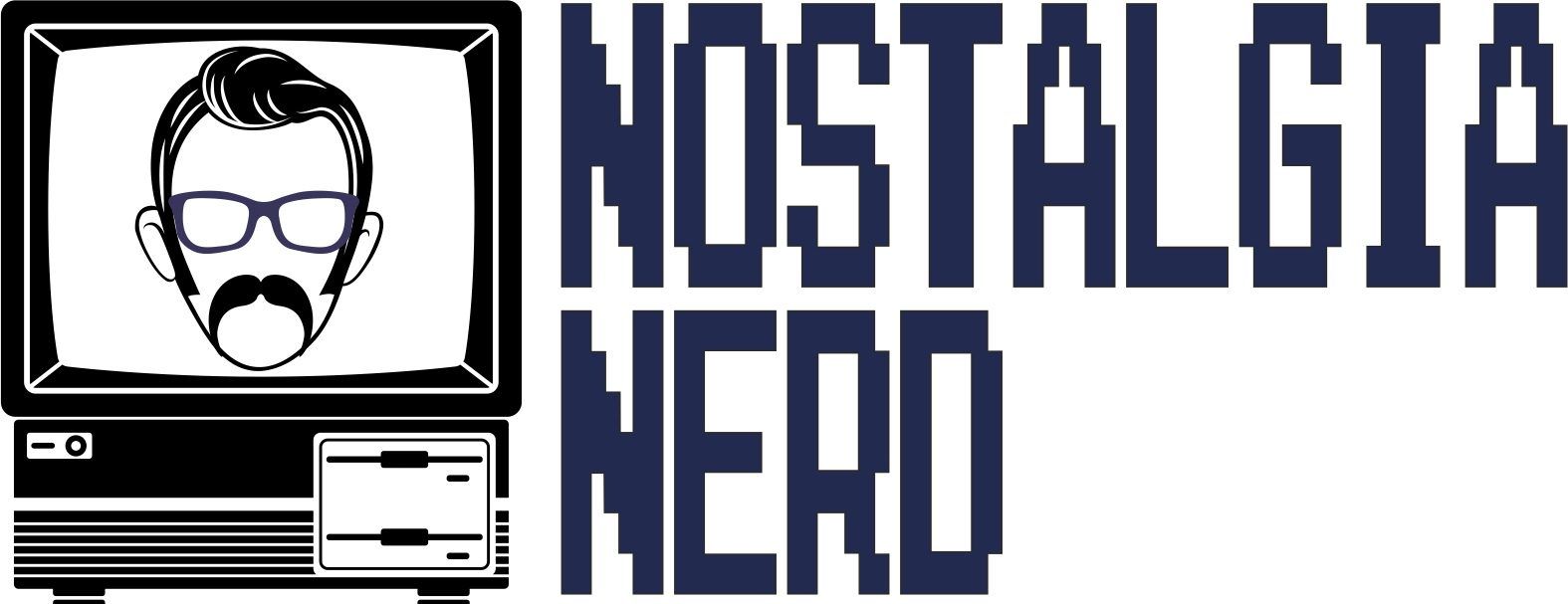
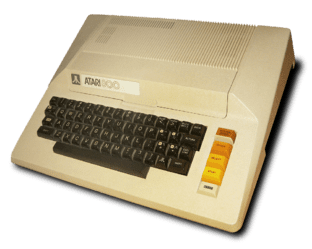
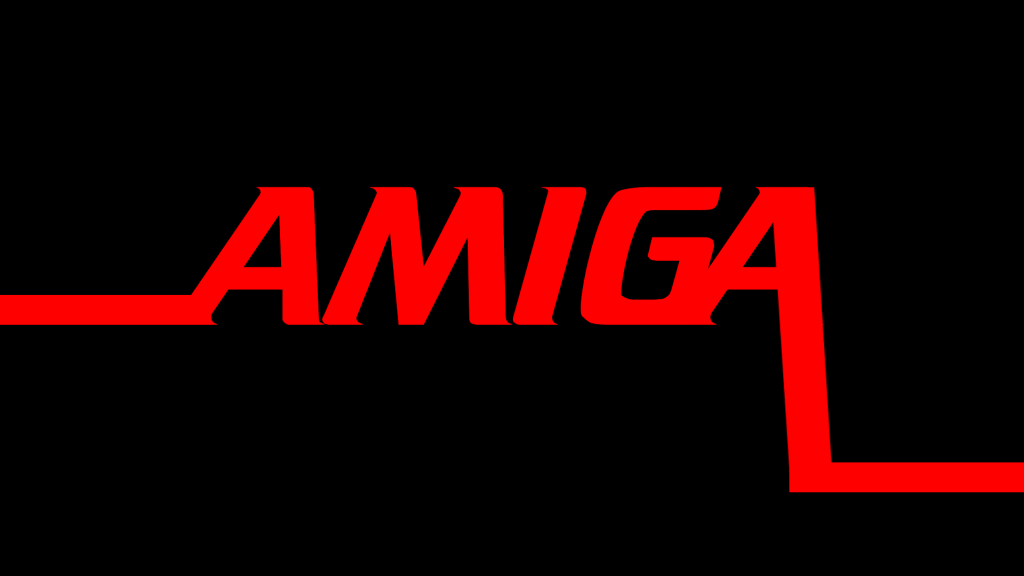
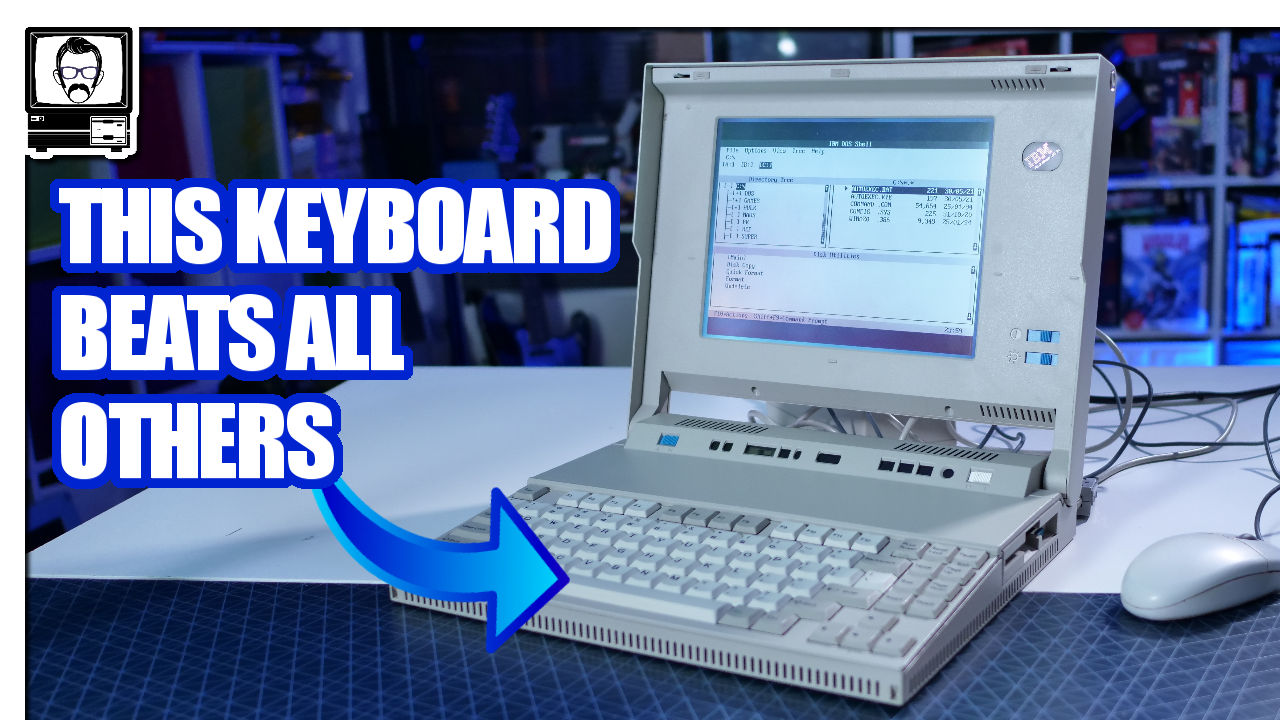
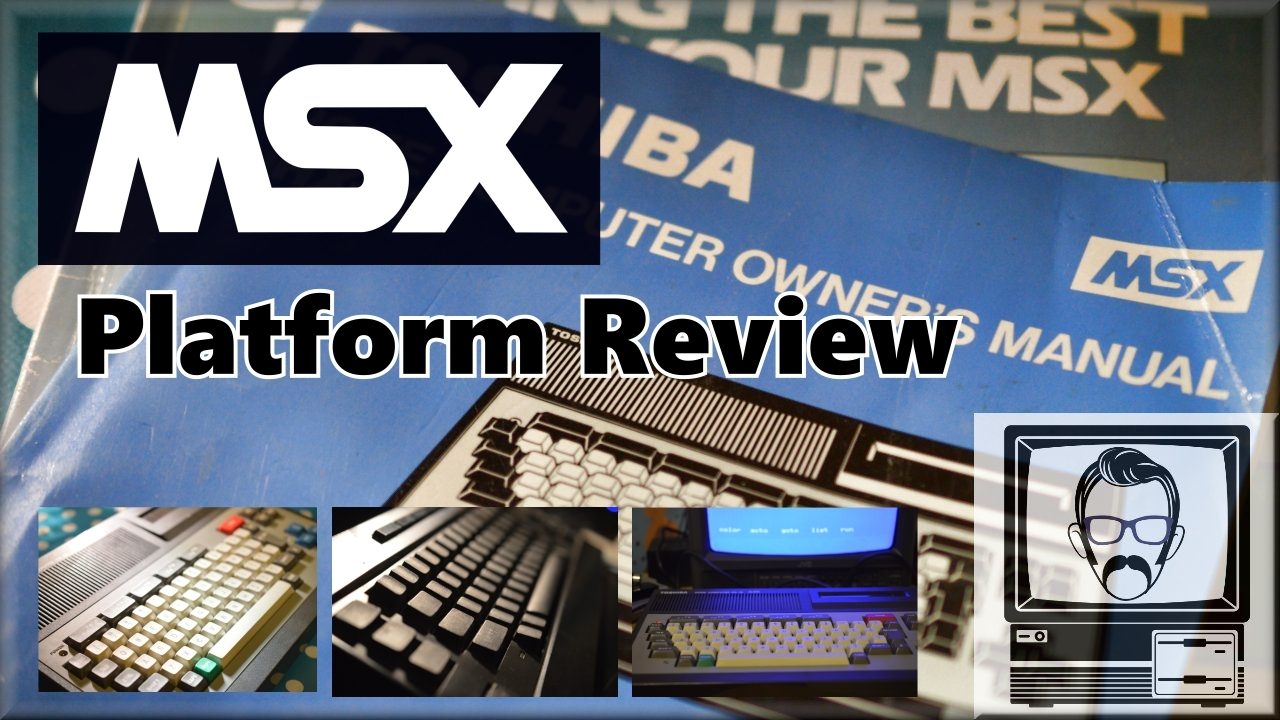
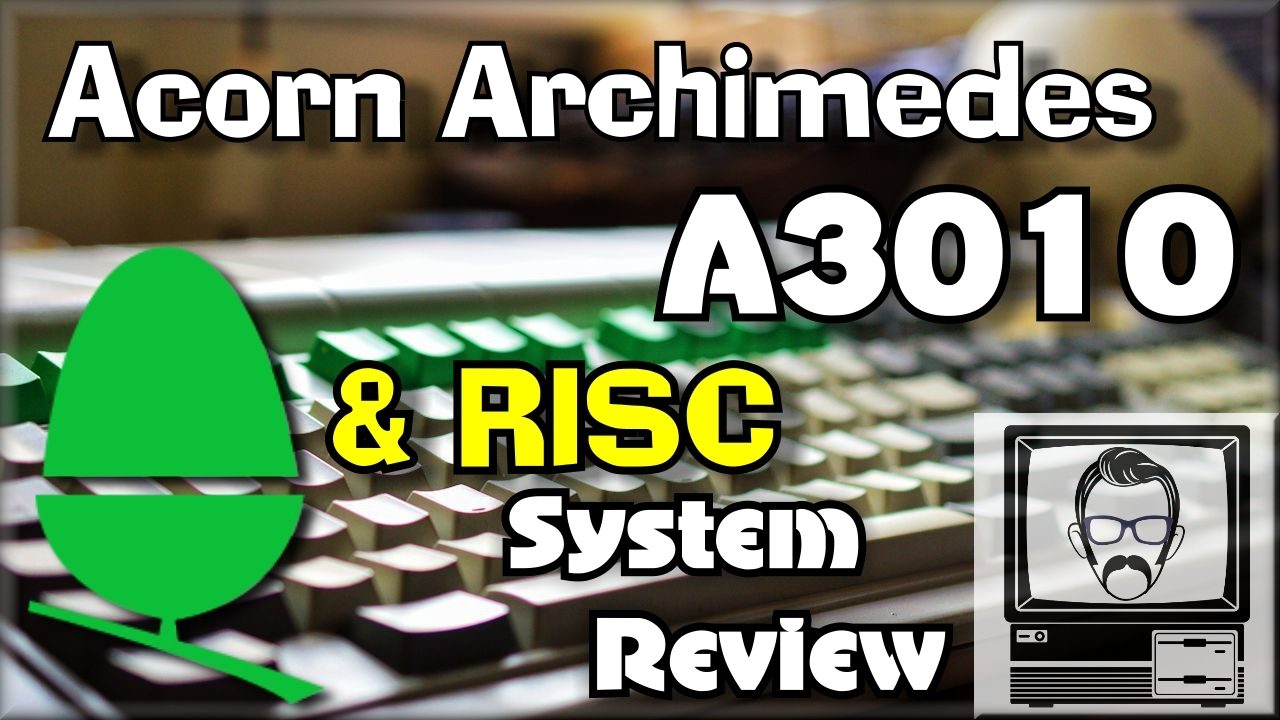

2 Comments
Add Yours →Thank you for this wonderful site. I never thought that the Amiga would be still strong today.This is thanks to guys like you. Thank you.
Seamus D
[…] The Amiga story : https://www.nostalgianerd.com/the-amiga-story […]